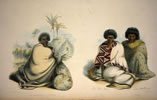Appointment of the British Resident
In the early 19th century European traders, whalers and settlers were increasingly coming to New Zealand. Māori, missionaries and other European settlers were concerned about the lack of legal restraints on behaviour and the need for some kind of government. The visit of the French ship La Favorite in 1831 led to British concerns about other nations annexing New Zealand.
In 1831, 13 northern chiefs, assisted by missionary William Yate, sent a letter to King William IV requesting his protection. As a result James Busby was appointed as British Resident in New Zealand (an official position). He arrived in 1833, but was not well equipped. He had no army or police force to support him, and he had to use diplomacy to achieve anything. He was described as a man o’ war (warship) without guns.
United Tribes’ flag
New Zealand-owned ships were in danger of being seized as they did not fly a national flag. In 1830 the Sir George Murray, a ship part-owned by chiefs Patuone and Taonui, was seized in Sydney for not having a national flag.
Busby called together a number of northern chiefs to vote for a national flag. Three options were presented, which had been organised by missionary Henry Williams. On 20 March 1834, at Waitangi, the chiefs selected one which became known as the United Tribes’ flag. It received a 21-gun salute, and was eventually recognised by the British king and became a national flag for ships from New Zealand. Busby hoped to get Māori to work together collectively and he hoped this new national flag might encourage inter-tribal cooperation.
The declaration is signed
As well as concerns about lawlessness, there had also been concerns about the interest in New Zealand shown by France and the United States. This came to a head in 1834 when a French national, Charles Philippe Hippolyte de Thierry was thought to be heading to New Zealand with a plan to declare a sovereign and independent state of Hokianga.
A number of northern chiefs were brought together by Busby at Waitangi to sign the Declaration of Independence. On 28 October 1835 the declaration was signed by 34 northern chiefs. Signatures continued to be added until 1839, by which time it had 52 signatures. These included the signatures of Te Wherowhero, the chief of Waikato who would later become the first Māori king, and chief Te Hāpuku of Ngāti Kahungunu.



